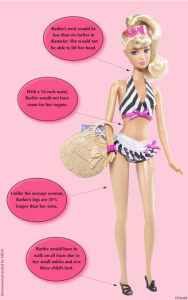 Icons our generation grew up with such as Amanda Bynes and Demi Lovato have something in common with more than half of university students – they suffer from eating disorders.
Icons our generation grew up with such as Amanda Bynes and Demi Lovato have something in common with more than half of university students – they suffer from eating disorders.
During the transition from high school to college life, students are bombarded by pressures from classes, social circles and personal goals. While adjusting, students also struggle to escape the dreaded freshman 15.
From Feb. 23-March 1, organizations around the country helped draw attention to another stigma rarely confronted. National Eating Disorders Awareness Week (NEDAW) aims to challenge the stereotypes and improve the support and treatment of conditions associated with eating disorders.
Murray State has hosted two events in honor of NEDAW, including the Life-Size Barbie exhibit in the Curris Center Rocking Chair Lounge. The Life-Size Barbie exhibit was new to NEDAW at Murray State due to conflicts with the typical display.
“The Life-Size Barbie exhibit is something that the National Eating Disorders Association or NEDA promotes,” said Abigail French, director of the Women’s Center at Murray State. “We were looking for new ideas because we normally do ‘Room-with-a-view,’ but with the renovations, Old Richmond (Residential College) was occupied.”
The shocking portrayal of the persona of perfection sparked interest in the student body.
Students were confronted with the fact that if Barbie were a real person, she would not be able to function like most humans.
“Lots of people were very interested in it,” French said. “The actual Barbie gets their attention and when they hear things like Barbie wouldn’t be able to stand on two legs or hold up her own head, it challenges the way people think about beauty.”
With the facts presented on a large poster in the Curris Center, the reality of Barbie caused students to question whether eating disorders were a problem on Murray State’s campus.
“A lot of students have asked questions about the Barbie, but then they begin to ask about the issue that surrounds it,” French said. “It is a conversation starter and has made students more aware and ask questions like, ‘Is this a problem?’ and, ‘What can I do to help?’”
The conversation started by the disproportionate Barbie model continued Tuesday in Mason Hall Auditorium as NEDA volunteer Emily Neff, Sarah Kerrick, counselor at Murray State, and David Fender professor at Murray State, spoke to students about how eating disorders affected their lives.
Though some testimonies were secondhand experiences, the reality of the impact eating disorders have on friends and family of the victims hit home.
“We have generally four to five students a semester that come in to get help for a friend,” French said. “We give the friends advice on how to be supportive and how to confront the situation. The more they know about eating disorders, the easier it is for the friends to talk to the one who is struggling with the disorder.”
Other positive outcomes from the Life-Size exhibit and eating disorders panel discussion include reaching students who struggle with body image and self-esteem, even if they do not have an eating disorder.
“I personally don’t believe all eating disorders are self-esteem issues,” French said. “I think it is personal and depends on the person, but I think eating disorders have the component that is dissatisfaction with yourself. Self-esteem is always important and so is general awareness.”
As NEDAW comes to a close, it is certain a handful of students have been made more aware of eating disorders and how to support those who struggle with them.
According to NEDA, positive relationships and support increase the likelihood of recovery from illnesses such as these. Raising awareness strengthens the individuals who struggle to move toward recovery.
Story by Hunter Harrell, Features Editor